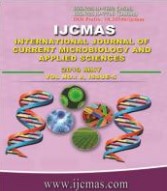


 National Academy of Agricultural Sciences (NAAS)
National Academy of Agricultural Sciences (NAAS)

|
PRINT ISSN : 2319-7692
Online ISSN : 2319-7706 Issues : 12 per year Publisher : Excellent Publishers Email : editorijcmas@gmail.com / submit@ijcmas.com Editor-in-chief: Dr.M.Prakash Index Copernicus ICV 2018: 95.39 NAAS RATING 2020: 5.38 |
Cotton is an important crop used globally for its natural fibre and seed. Fusarium wilt, caused by the fungus Fusarium oxysporum f. sp. vasinfectum, is a major disease of cotton capable of causing significant economic loss. The fungus persists in soil as chlamydospores and in association with the roots of susceptible, resistant and non-cotton hosts as well as in seed. In the present investigation, the major cotton growing areas of Tamil Nadu were surveyed for assessing the per cent wilt incidence, the maximum disease incidence of 28.47 per cent was recorded at Coimbatore (Loamy) followed by 24.65 per cent at Salem (Clay loam) and a minimum of 7.65 per cent incidence at Madurai with silty loam soil texture. The number of micro conidia was more as compared to macro conidia. Abundant chlamydospores were observed terminally and intercalary. The size of the macro conidia, micro conidia and chlamydospores of the virulent isolate TRY (Trichy) was 26.20x6.25µm, 13.65x4.18µmand11.87x11.48µmrespectively.
 |
 |
 |
 |
 |